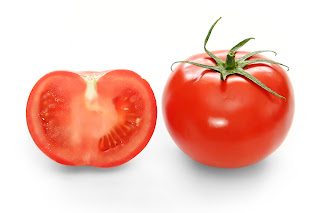The truth is, everything about culture can be explained by
the tomato.
Figure 1: The answer
to all things
To prove this let me ask you to jot
down 3 common recipes cooked day-to-day in your home. Let me pick out 2
examples, one from the North, and the other from the South. These are both the
first google results that popped up on searching for these dishes:
Butter Chicken
Ingredients:
1 kg boneless
chicken skin removed
Juice of 1 lime
Salt to taste
1 tsp red chilli
powder (adjust to suit your taste)
6 cloves
8-10 peppercorns
1" stick of
cinnamon
2 bay leaves
8-10 almonds
Seeds from 3-4 pods
of cardamom
1 cup fresh yoghurt
(must not be sour)
3 tbsps
vegetable/canola/sunflower cooking oil
2 onions chopped
2 tsps garlic paste
1 tsp ginger paste
2 tsps coriander
powder
1 tsp cumin powder
1/4 tsp turmeric
powder
400g/
14 oz of chopped tomatoes, ground into a smooth paste in a food processor
1/2 litre chicken
stock
2 tbsps kasuri
methi (dried fenugreek leaves)
3 tbsps unmelted,
soft butter
Salt to taste
Coriander leaves to
garnish
|
Sambhar
Ingredients:
1 cup toovar
(arhar) dal
1
tomato, chopped
1 onion, chopped
2 brinjals (baingan
/ eggplant), cubed
1 drumsticks
(saijan ki phalli / saragavo), cut into 4 pieces
1 potato, cubed
1 tbsp tamarind
(imli) pulp
salt to taste
For the sambhar masala
6 to 8 whole dry
kashmiri red chillies
1 tbsp coriander
(dhania) seeds
1 tsp toovar
(arhar) dal
1 tbsp chana dal
(split Bengal gram)
1 tbsp urad dal
(split black lentils)
1 tsp turmeric
powder (haldi)
1/2 tsp asafoetida
(hing)
1 tsp oil
For the tempering
1 tsp mustard seeds
( rai / sarson)
6 curry leaves
(kadi patta)
1/4 tsp asafoetida
(hing)
2 tbsp oil
|
It is likely your recipes would have ended up with
a tomato somewhere as well. Tomatoes seem to form the base of half the North
Indian dishes, and is commonly found in sambhar, rasam, chutneys and set-dosas
in the South. It’s an integral part of our mother’s recipes – that bastion of
tradition and culture.
And yet, as the young chef in my novel points out to
his stubborn grandfather (yes, shameless plug) – tomatoes originated in the Americas.
Here’s the Wikipedia version of our philosophical fruit’s journey:
http://en.wikipedia.org/wiki/Tomato#History
So how did our mothers turn American? When did this
westernizing influence corrupt our cuisine? How come the RSS didn’t tell us? Most importantly, if ancient (and medieval) Indians
didn’t have tomatoes...what did they put in their curries?
Boring stuff, it turns out.
But more interestingly, the tomato incident
highlights a fact of culture that its guardians seem to forget – it is a river,
not a bedrock. Even the most traditional thing was new once upon a time, probably
taken from another people, transmuted, transmitted, twisted and tailored in an
unending process.
In fact, much of the confusion comes from the
context we view the word in. What is Indian culture? It’s classical dances and
music? It’s traditional clothes? It’s cuisine? The body of its literature?
If we say it is all these things, then we confine
the word to the part of culture that is the past. In this context, four hundred
years ago, tomato wouldn’t be a part of Indian culture.
And yet, we cannot ignore that a major part of
culture lies in our inheritances, the habits of our past and our families,
passed down. It reaches so deep in our souls that it moulds the very way we
think – how we view personal space, how we view different relationships, how
our hands move when we talk, how we behave with those who have power over us,
and those in our power. I have lived in many countries, and in countries that
have people from all over, and the majority of them (including me) find it next
to impossible to even form a genuine connection with a person from another
culture. Such is the empire in our hearts, and the influence of the past.
In fact, if I don’t get Indian food (with tomatoes)
for more than two weeks, I can’t stand it.
And that is the Tomato Paradox of Culture:
I cannot live without tomato flavoured curry –
since I grew up with it as part of my culture and that has molded me. Yet, the
presence of that tomato proves that culture changes, and we mold culture.
I think, overall, it’s far easier conceptually to just separate
out the word. Let the word culture consist of 2 parts: Active Culture
and Passive Culture.
Passive Culture is the habit of our past that
is passed down by our family in our childhood. This includes aesthetic habits,
dietary habits, body language habits, world view habits, lifestyle habits. It’s
our social psychology.
Active Culture is the body of similar
decisions a large portion of society takes in response to similar stimuli and
rationale. Like the decision of cutting vegetables and doing other parts of
housework working ladies take in the long hours spend in the Mumbai Local. Like
the decision so many households take to make their children memorize for exams,
and go into engineering. Like the collective lust we feel for increasingly
vigorous item numbers. It’s the economics of our daily lives.
At all points Active Culture erodes Passive
Culture. The insidious tickling of collective lust legitimizes a slow simmer of
sexual revolution, upturning existing cultural mores. The presence of
air-conditioned, clean retail spaces slowly wear away our cultural relish of
haggling with unorganized retailers. The presence of a tasty, cheap new ingredient
(like Maggi, and many centuries ago the tomato), changes the proportion of our
food where its included, slowly changing our cultural cuisine.
But Active Culture also becomes new Passive Culture bit
by bit as generations turn – our mothers gave us Maggi, so we give it to our
children. Our frequenting of malls leads to our children becoming more fashion
conscious. Our increasing comfort with seeing mainstream stars go sexual
changes the way our children grow up thinking about sexuality.
And in the transformation of Active Culture into
Passive Culture, in that natural alchemy, lies a pot of gold – a transformation
of the consumer and society where the old becomes meaningless, and the new
becomes rich.


















